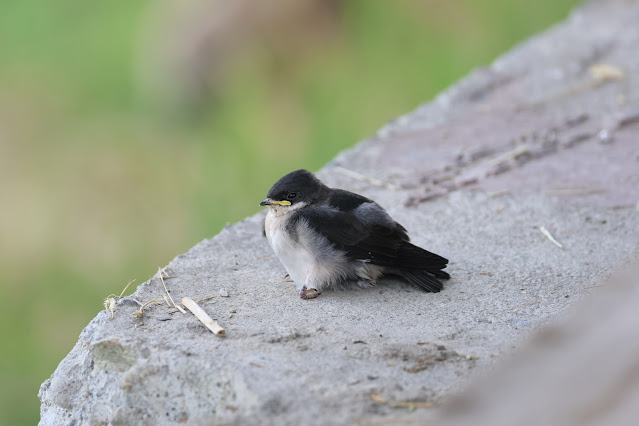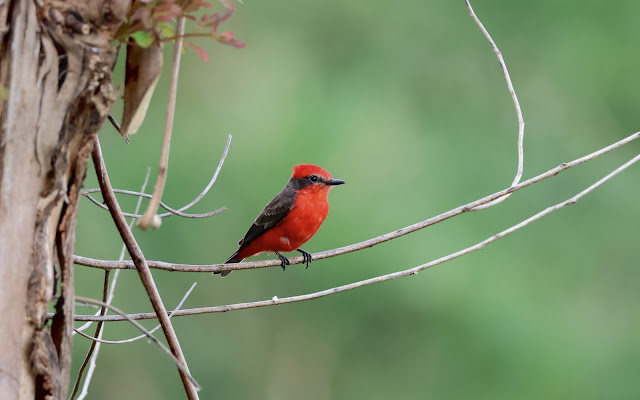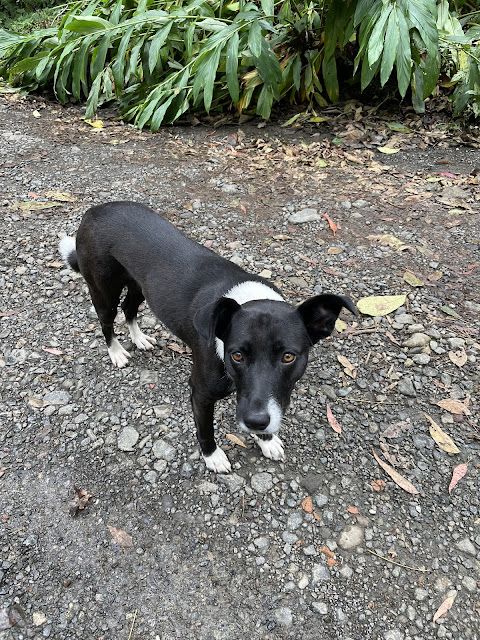The next full day in Colombia was spent in La Florida but first a couple photos from the previous afternoon drive. We stopped at a roadside restaurant overlooking a valley and after ordering a few of us went outside to explore our surroundings. Since the beginning of the trip, I was frustrated by trying to photograph a couple swallow species that we only were seeing in flight. Luckily for me at this restaurant, a recently fledged chick had fallen out of a nest in the rafters.
Blue-and-white Swallow chick.
Blue-and-white Swallow mom or dad looking down at their chick.

A scruffy-looking Southern Rough-winged Swallow
The meal was delicious but I wolfed it down and went back outside while others finished up and did their bathroom rituals.
A pair of Vermilion Flycatchers were hawking insects.
Carib Grackles were mainly only seen at roadside stops during the trip for some reason.
We made it to La Florida by early evening and had enough time after checking in to walk a short stretch along the river by the hotel. The main target was the famous Torrent Ducks! I have been wanting to see this species for a long time and the local guide said we should have a good shot at them at this river.
White-capped Dipper! Not the bird I was expecting but I will take it.
In the morning we headed early on a long 4x4 drive up to the Otun Quimbaya Preserve so we could be at our breakfast spot at first light. This forested preserve is beautiful but as with many heavily forested places, getting decent looks at the birds is tough. We did pick up a few though and I did my best to obtain photos in the poor light.
Ashy-throated Chlorospingus was the first bird of the day.
A Collared Trogon sat on the wire directly above where we ate our eggs prepared by the people who were manning the ecostation.

Yellow-bellied Seedeater at the tippy-top of a Cecropia tree.
Smoke-colored Pewee
Plumbeous-crowned Tyrannulet

Slate-throated Redstart

A groovy moth I have yet to ID.
Montane Woodcreeper
Another Plumbeous-crowned Tyrannulet
We had many dogs pay us a visit throughout all the days in Colombia but this one was my favorite and apparently I was his favorite because he followed me the whole time we were up there even when I walked off on my own as I tend to do. It broke my heart when we had to leave.
I have so many butterflies I need to ID now.
Bronze-olive Pygmy-Tyrant

Stile's Tapaculo - Considering how hard it usually is to see a Tapaculo, we were happy to actually get some half decent pics. And this one was a Colombian endemic!
Crested Ant-Tanager - another Colombian endemic! This one is hard to find as well, so I will have to deal with this horrible photo.
Multicolored Tanager - yet another Colombian endemic! Although all the looks at these birds was sub-optimal with most of the birds either way at the top of large trees or hidden way back in dark undergrowth, the number of endemics we were racking up was impressive.
Metallic-green Tanager - although this one can also be seen in Ecuador and Peru, this is the only one we got on the trip.

Cauca Guan! Not only is this bird a Colombian endemic, it is super restricted in its range and was almost hunted to extinction. In the 1980s it was thought to be extinct, but some were found in the Cauca valley and luckily they seem to be thriving in Otun Quimbaya.
This is the range map.
We ended up seeing about 10 of them.
Red-ruffed Fruit Crow! Although this large bird can be found in several places in South America, they are usually very hard to find and this forest reserve is one of the best places to see them. Fruit Crows are actually not crows at all, they are in the family Cotingidae. They are one of the largest of all passerine (song) birds.
We made it half way down the preserve road and stopped at another eco station for lunch.
Check out the awesome preparation for this meal! Chicken, pork, rice, plantains, eggs and some other goodies wrapped and steamed in banana leaves.
Yum! As I usually did, I wolfed this down and went out birding around the eco station while most others finished some coffee. It had rained during lunch and as is frequently the case in the forest, birds get active after a rain maybe because it caused insects and other tidbits to emerge.
Cramer's Eighty-eight Butterfly
Yellow-Olive Flatbill - I had one of these in Mexico some years back.
Yellow-backed Oriole - funny that I also had one of these in the Yucatan probably on the same day I had the flatbill - birds of a feather flock together.
Black-winged Saltator!

Another Red-ruffed Fruit Crow

Female Yellow-bellied Seedeater
Golden-faced Tyrannulet
Oleaginous Hemispingus
Marble-faced Bristle-Tyrant
It started to rain pretty hard so we decided to pack it in but I worked on the guide on the way back to the hotel and pleaded for another try at the Torrent Ducks. I was so glad he did stop! In fact he ran out to the river in the pouring rain to check a spot he has seen them before and came back to the 4x4s with a thumbs up!
Torrent Duck - it was so cool to watch these ducks working the raging river.
Here is a wider shot so you can see the habitat for these daredevils. They somehow can swim under the torrents and in fact they can swim quite fast upstream. I wish I had taken some video but again it was raining pretty hard.

White-capped Dippers were also around.
The Tortilla Soup dinner at the hotel was the perfect way to end the day!



































































